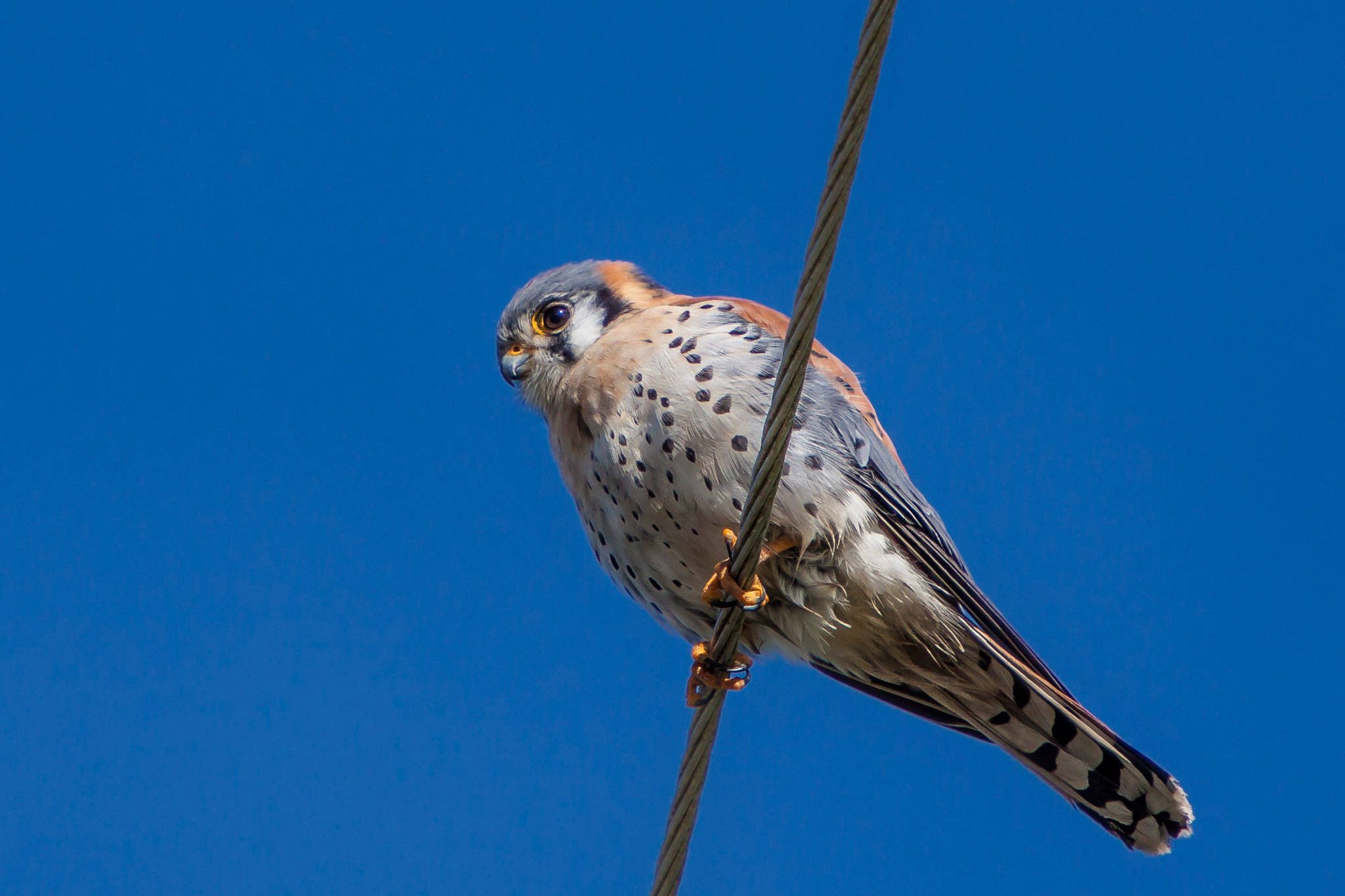Over the years I have had a few memorable experiences with the American Kestrel, from seeing one inside the fence of the largest compound at the La Brea Tar Pits right on Wilshire Blvd in L.A.’s “Miracle Mile”, to another lying on its back in the middle of an intersection being held down by a Merlin. I drove my car at the two to prevent mayhem; they flew off in opposite directions both yelling invectives at me as they left. But my favorite experience was up on Chelan Ridge with HawkWatch International, with the guy I was paired with offering to remove a kestrel from the mist net, stating his hands were tougher than mine, and watching as the bird tried its best to tear Bob’s hand apart. My mom was right: dynamite does come in small packages! The kestrel is one tough little Falcon so don’t try to pick one up. Enjoy this photo by Dasha Gudalewicz of a colorful male in the sun.
General Description: The American Kestrel is our smallest falcon, standing 9 inches tall, with a wingspan of about 22 inches, and weighing in at just over 4 ounces. The male is more brightly colored of course with a reddish-brown back, slate-blue wings streaked with black, and a tan breast with black spots. His head is slate blue and brown, while the female has the same reddish brown back, tail, and reddish brown wings, with black barring on her back. Both sexes have black vertical stripes on the sides of their faces and a black sub-terminal band on their tail, with the male band being wider than the female’s.
Habitat: Kestrels are found in many types of areas of the county, from open grasslands, agricultural fields, and openings in dry forest zones, to clear-cuts with lots of perching possibilities.
Behavior: Kestrels spend a lot of time either perched, waiting for prey, with their tail bobbing, or hovering in place, facing into the wind, tail adjusting to keep them in place as they hunt from above. They can even be found hunting moths from stadium lights during night games, making it onto prime time on occasion.
Diet: The diet of the American Kestrel is mainly large insects such as grasshoppers, small mammals, small birds, and occasionally reptiles. Farmers often put kestrel nest boxes on poles in their fields to encourage the birds to stay in the area and help with pests.
Nesting: These are primarily cavity nesting birds, usually 10 to 30 feet off the ground. Old woodpecker holes, natural cavities, and man-made nesting boxes are all used. They will also nest in openings in man-made structures. Pair bonds are monogamous. The male finds a likely nest site then shows it to his mate for her approval. They do not add nesting material, or shove already existing material to the side and she lays 4 to 5 eggs in the cleared area. Both parents incubate the eggs for 29 to 31 days, then the female broods the hatchlings and the male brings food for all. The young fledge at 28 to 31 days, but may return to the nest for another 12 to 14 days for feeding by adults.
Migration: Most western Washington kestrels remain year-round, but they may be joined by birds from farther north migrating into our area during the winter. Eastern Washington birds may migrate to the southern United States for the winter.
Conservation Status: There has been a significant decline in Washington between 1966 and 2002, probably due to loss of nesting cavities. They are also victims of increased predation by Cooper’s Hawks, a species that has rebounded in recent years. If you would like to help the kestrel “go forth and multiply”, they adapt well to man-made nest boxes. You can find directions to build some for your neighborhood here: https://tinyurl.com/ycuhxb9g
When and Where to Find on Grays Harbor: The best spots to reliably find these little tyrants are in the agricultural fields around the Monte-Brady Loop. It’s a pleasant drive on back roads, and there are many birds to see in that area. Just watch for a small bird, hunched over while perching on the lines, tail pumping, attention fixed on the ground below. If you are lucky and watch for long enough, you may get to see one grab a grasshopper off the ground, return to the wire, then stand on one leg and hold its prey with the other foot. They are an amazing little creature!



